Chess Openings for Beginners: A Simple Introduction
In chess, the first moves can decide how the whole game will unfold. This is why chess openings for beginners are so important. A good start helps you build confidence and sets you up for success later in the game.
“The opening is where you lay the foundation of your house.” – Tigran Petrosian
Chess openings are the first few moves each player makes. They shape the board, create opportunities, and prepare for the middle game. For beginners, understanding why these moves matter is more valuable than trying to memorize endless sequences.
Instead of learning long, complicated lines, focus on simple rules and ideas. By doing this, you’ll build habits that improve both your openings and the rest of your play.

Table of Contents:
The Main Goals of the Opening
1. Control the center
The center squares (e4, e5, d4, d5) are the most powerful spots on the board. Pieces that control the center have more impact on the board and more activity. Winning the center often means winning the initiative. The most common starting moves 1.e4 and 1.d4 do exactly that – fight for the center of the board.
2. Develop your pieces
The opening stage is when the pieces move from their starting positions to better squares where they have more activity. Pieces influencing the center are usually stronger than those that don’t. For example, a knight on f3 is more active than a knight on h3.
3. Castle as soon as possible
Castling is very important for two reasons. It brings the king to safety and connects the rooks. A safe king and active rooks give you a much stronger position to fight from. To learn more about this special move, check out my blog post on Castling.
Most Common Beginner Mistakes in the Opening
1. Develop the queen too early
One of the classic mistakes in chess openings for beginners is bringing the queen out too soon. The queen is a very valuable piece and can easily become a target. That’s why the queen is usually developed later in the opening stage.
2. Play too many pawn moves
Pawns are usually pushed forward for two reasons – control the center and let your pieces out. You should develop your pieces, not the pawns. So, if you are thinking about pushing the h-pawn to h3, make sure it is either necessary as a precaution or genuinely improves your position.
3. Play with the same piece more than once
Another common mistake is moving the same piece more than once in the opening. Doing this neglects your other pieces that are still on their starting squares. As a result, you can fall behind in development.
Best Chess Openings for Beginners
As White
1. Italian Game (1.e4 e5 2.Nf3 Nc6 3.Bc4)
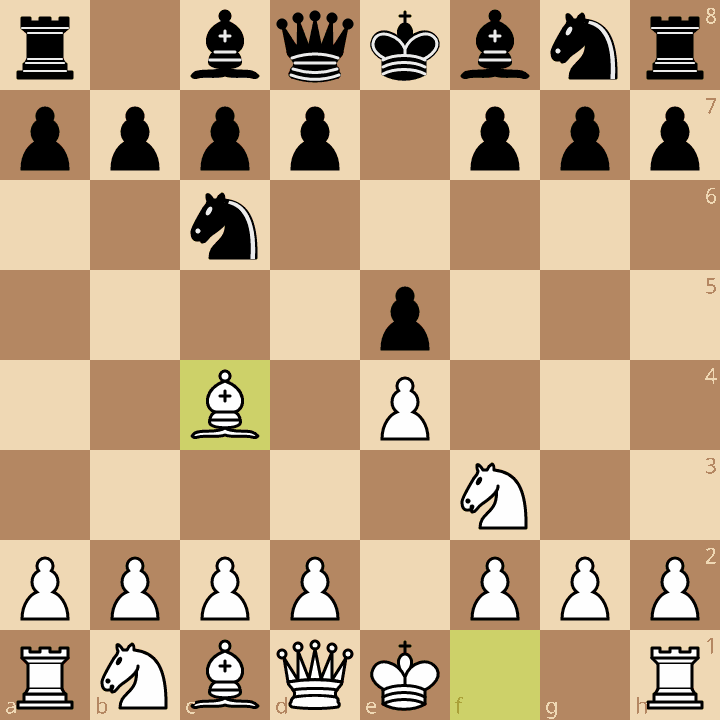
The Italian Game is simple to understand, teaches key opening principles, and helps beginners build a strong foundation for the middle game.
2. Alapin Sicilian (1.e4 c5 2.c3)
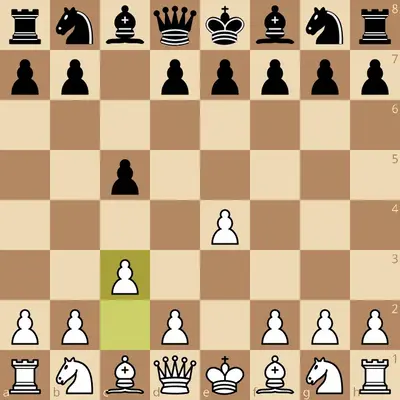
Alapin Sicilian is a simple way for white to fight for the center without entering the sharp main lines of the Sicilian. The plan is easy to understand: build a strong pawn center and develop pieces quickly. This makes it a good opening choice for beginners who want a clear, safe approach against the Sicilian Defense.
3. French Defense: Exchange Variation (1.e4 e6 2.d4 d5 3.exd5)
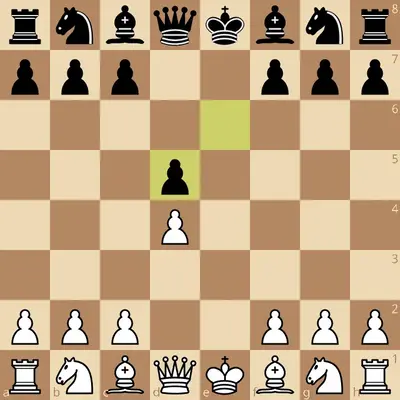
By exchanging pawns early, white gets a symmetrical pawn structure. This makes the position simple and easy to understand for beginners. It teaches key ideas like piece development, central control, and safe king placement without complicated and sharp variations.
4. Caro-Kann: Exchange Variation (1.e4 c6 2.d4 d5 3.exd5 cxd5)
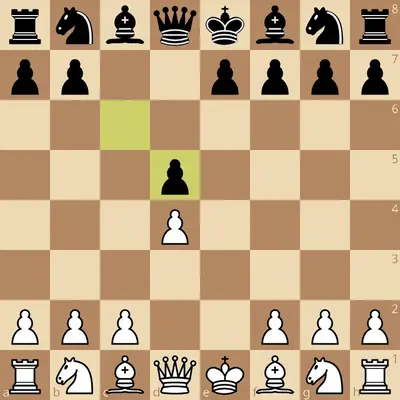
This opening gives white a very solid pawn structure while keeping the position open for piece development. It often leads to a slower, strategic game where understanding plans is more important than tactics.
5. London System (1.d4 followed by 2.Nf3 and 3.Bf4)
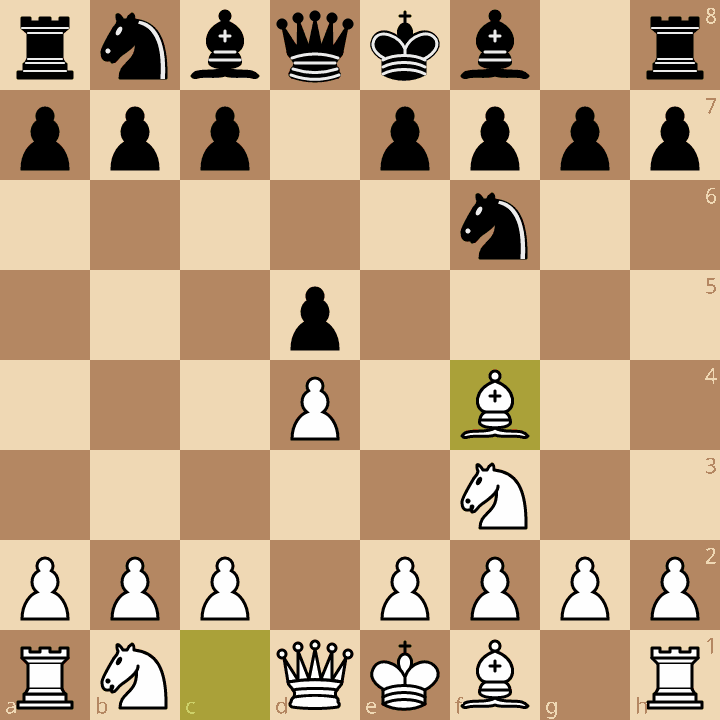
The London System is a solid and flexible opening that is easy for beginners to learn. This opening focuses on piece development and a strong, safe pawn structure rather than memorizing long lines.
As Black
1. Open Game (1.e4 e5)
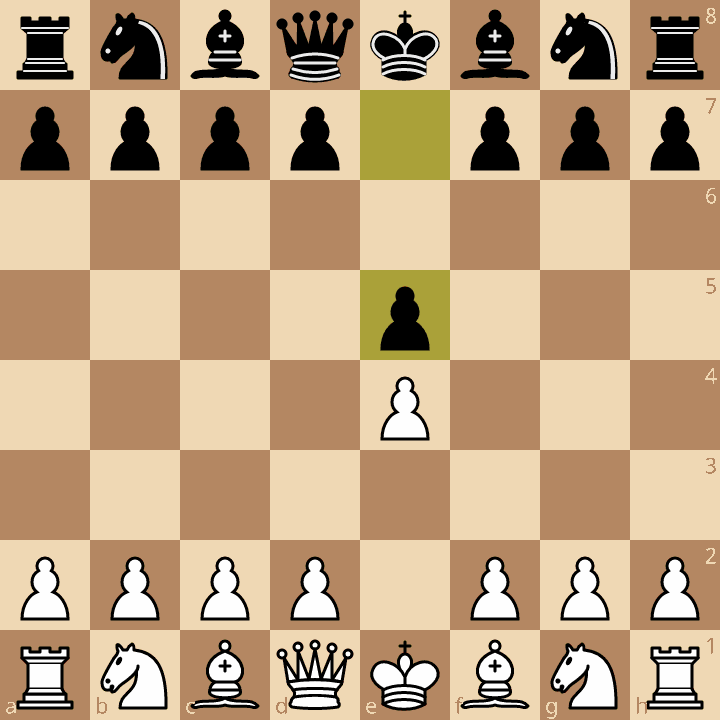
The Open Game fights for the center immediately. It is one of the best chess openings for beginners because it teaches key principles like piece activity, castling, and central control without becoming too sharp or complicated.
2. Slav Defense (1.d4 d5 2.c4 c6)
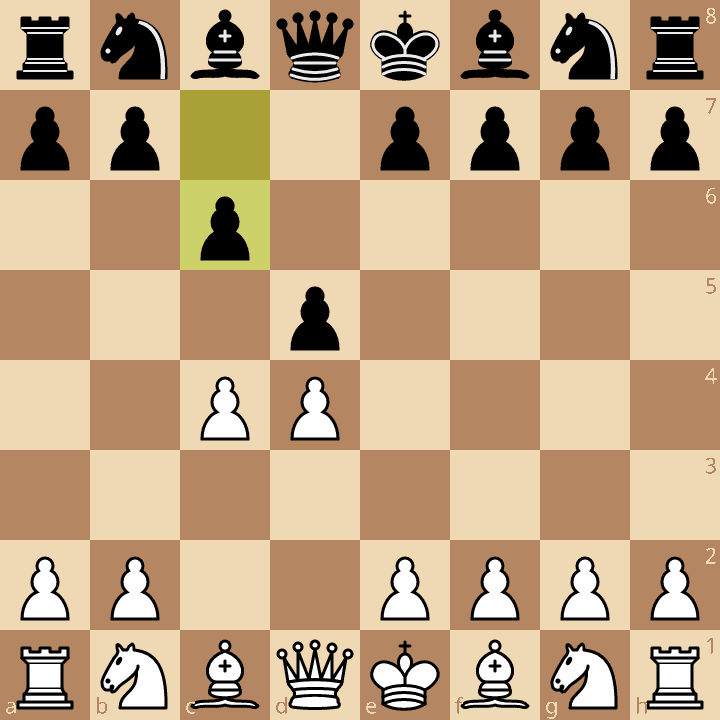
The Slav Defense is a solid opening for Black that focuses on supporting the center and developing pieces safely. The pawn structure is strong, which helps prevent early attacks from white. This makes it a great choice for beginners who want a simple plan and a safe position while learning key opening principles.
3. Queen’s Gambit Declined (1.d4 d5 2.c4 e6)
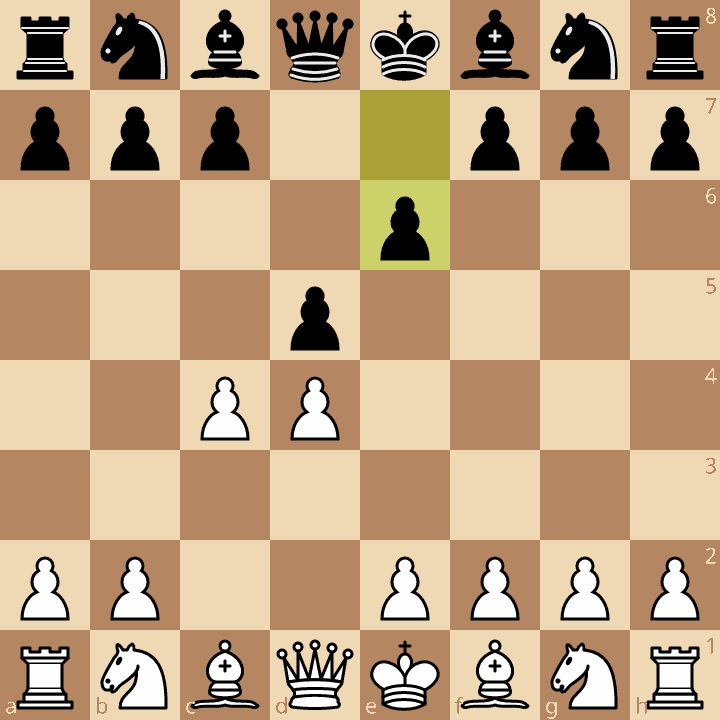
Queen’s Gambit Declined is a solid and safe opening, giving black a strong position while learning basic opening ideas. This makes it an ideal chess opening for beginners who want a simple and reliable plan.
Want to master the opening stage and find the perfect opening for your playing style? Contact me today to receive personalized guidance and start your journey toward chess improvement.
Practical Opening Tips for Beginners
1. Learn a few openings well
It’s better to focus on one or two openings for white and black and understand them deeply. Learning many openings superficially can be confusing and won’t help you develop good habits.
2. Focus on ideas and piece placement
Instead of memorizing long sequences of moves, pay attention to the reasons behind each move. Know why you are developing pieces, controlling the center, and keeping your king safe. Understanding these ideas will make your games much stronger.
3. Stick to solid openings first
Everyone likes a quick win, right? That’s why many beginners choose unsound gambits as their main opening weapons. You might score a few quick wins, but what happens when you face stronger opponents who know how to punish a poor opening choice?
Focus on solid chess openings for beginners first to practice fundamental principles. Once you understand the basics, you can safely experiment with sharper or more aggressive lines.
Following these principles is the best way to approach chess openings for beginners and prepare for long-term improvement.
Where to Learn Chess Openings for Beginners
Beginners can learn openings effectively from several sources:
The Lichess Opening Explorer is a free tool that helps you study and practice chess openings. You can see the most common moves in any position, explore different lines, and learn how top players respond. It’s a great way for beginners to understand opening ideas, try them in games, and improve without memorizing long sequences.
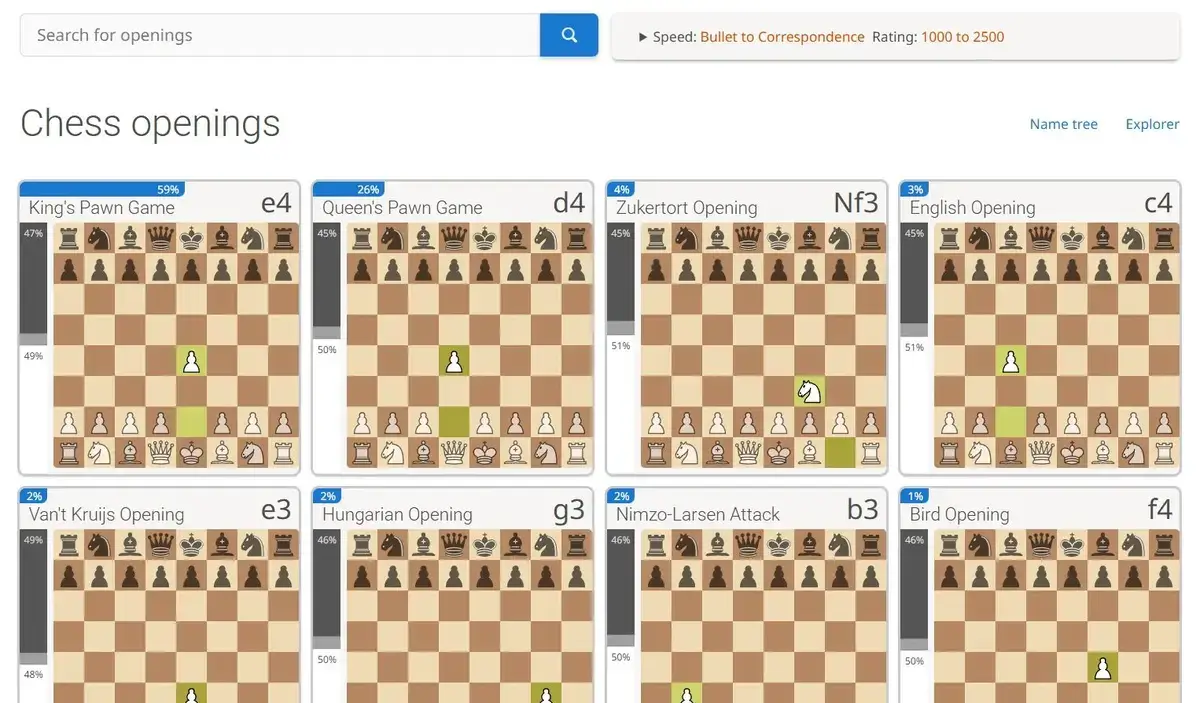
2. Chess books
Chess books are a great way for beginners to learn openings and understand the ideas behind them.
Discovering Chess Openings: Building Opening Skills from Basic Principles by John Emms emphasizes understanding basic principles rather than memorizing lines. Readers are guided through key themes like piece development, central control, and king safety, making it ideal for beginners who want to build a strong foundation in opening play.
Winning Chess Openings by Yasser Seirawan is a beginner-friendly guide that teaches the ideas behind openings rather than just memorizing moves. The book uses examples from popular openings to show how key principles like piece development, central control, and king safety apply in practice.
Conclusion
Mastering chess openings for beginners is all about building a strong foundation.
Focus on controlling the center, developing your pieces efficiently, and keeping your king safe. Avoid common mistakes like moving the queen too early, pushing too many pawns, or using the same piece multiple times.
Learn a few openings well and understand the ideas behind each move rather than memorizing long lines.
Stick to solid, principled openings first, and once you feel comfortable, you can explore sharper or more aggressive options. By following these guidelines, you’ll start your games confidently and set yourself up for success in the middle and endgame.
Explore my related blog posts:
Frequently Asked Questions
1. What are the three golden rules of chess openings?
The three golden rules of chess openings are: control the center, develop your pieces quickly, and castle early to keep your king safe. Following these rules helps you build a strong position, prepare for the middle game, and avoid early mistakes.
2. Is Ruy Lopez good for beginners?
The Ruy Lopez is a good chess opening for beginners, but a bit more complex than the Italian Game. Both start with 1.e4 e5 2.Nf3 Nc6, but the Ruy Lopez (3.Bb5) focuses on long-term strategy, while the Italian Game (3.Bc4) is simpler and easier to understand. Beginners often find the Italian better for learning basic development and center control.
3. Should beginners memorize chess openings?
Beginners should not focus on memorizing openings. It’s more important to understand the ideas behind each move, like controlling the center, developing pieces, and castling. Learning concepts helps you play better in unfamiliar positions and builds a stronger foundation for the middle game.
4. How many openings should a beginner learn?
A beginner should focus on one or two openings for white and black. Learning a few well helps you understand ideas and plans, while trying to memorize many openings can be confusing and ineffective.
5. What’s the easiest opening for beginners to play as white?
The Italian Game (1.e4 e5 2.Nf3 Nc6 3.Bc4) is considered to be one of the easiest chess openings for beginners. It teaches key opening principles like piece development, center control, and early castling, without complex theory.
